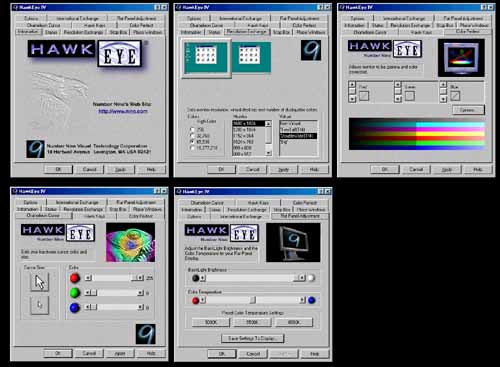Number Nine Revolution IV & Digital Flat Panel Solution Pack
by Anand Lal Shimpi on December 6, 1998 7:41 PM EST- Posted in
- GPUs
The installation of the Revolution IV was a breeze. The 32MB AGP version AnandTech received for evaluation installed in AnandTech's standard professional workstation without a single problem. The test system consisted of a Pentium II 333, an average speed processor for a workstation, an ABIT BH6 motherboard, 64MB of PC100 SDRAM, an Ethernet card, a Western Digital Caviar 5.1GB UltraDMA HDD, and a CD-ROM drive.
Under Windows 98, the installation procedure consisted of nothing more than popping in the #9 Revolution IV installation CD and pointing Windows in the direction of the display drivers. The same ease of operation/installation was present under Windows NT 4, using the drivers which are also located on the same CD. For compatibility testing, the Revolution IV drivers were installed over a previous set of Matrox drivers to simulate an average install, and unlike most other video accelerators AnandTech has tested, the drivers installed without so much as a hiccup from the system.
Included with the installation CD-ROM is #9's own set of desktop graphics utilities that help take advantage of the Revolution IV's capabilities. Instead of placing 10 new tabs into your display properties control panel, the installation utility creates a new HawkEye IV control panel which happens to be the name of #9's patented utility.

Using the HawkEye utility you can configure virtually every facet of the Revolution IV's setup, including features such as color temperature, virtual desktop area and configuration, hotkeys, display properties shortcuts, cursor size and color, and much more. This is all in addition to the standard configuration options like color depth, resolution, and refresh rates.
Quality Specifications
Speaking of refresh rates, the refresh rates supported by the Revolution IV and driven by the 250MHz RAMDAC are truly amazing. At 1280 x 1024 you can achieve a 107Hz refresh rate at 32-bit color, and at 1600 x 1200, the 92Hz refresh rate isn't too shabby at all. Even at 1920 x 1200, the 77Hz refresh rate should be easy viewing for most users blessed with a monitor large enough for that resolution.
While the card itself doesn't ship with a Windows 9x OpenGL ICD, under NT you are able to take advantage of the card's OpenGL acceleration. The main focus of the Revolution IV, once again, isn't gaming, so don't expect to break the 40 fps barrier in Quake 2 or anything, but keep in mind that just because the card isn't a gamer's solution doesn't mean that it can't be used for professional 3D rendering/applications. The Revolution IV couples outstanding 3D image quality with OpenGL support that'll be useful for all 3D CAD and other 3D modeling applications from a professional perspective, but as a gamer, the Revolution IV isn't a desirable card.
According to #9, the Revolution IV supports Microsoft's forthcoming 4D specification for use with GDI-2K (3D navigable Windows), while you won't see GDI-2K debut until late in 2000 it is an interesting feature to support this early.
While the card AnandTech tested was an AGP 2X version equipped with 32MB of SDRAM, the card specifications support for 32MB of WRAM with an interleaved 256-bit memory interface as opposed to the 128-bit WideBus memory bus standard on the card.
Performance
The 333MHz Pentium II system AnandTech used to simulate a professional workstation was used in conjunction with Ziff Davis' Graphics Winbench 99 to illustrate the performance differences between the Revolution IV and its biggest competitors from Matrox. 3D Gaming performance was left out of the comparison due to the nature of the card itself, however the Revolution IV's Direct3D performance is comparable to that of the Matrox MGA-G200, producing frame rates within 5% of the G200 as seen in the AnandTech Mystique G200 Review.
Ziff Davis Winbench 99 - High End 2D Performance |
|||
| - | 1024 x 768 | 1024 x 768 | 1600 x 1024 |
| - | 16bpp | 32bpp | 32bpp |
Matrox Millennium II AGP |
295 | 267 | N/S |
Matrox G200 16MB |
344 | 336 | N/S |
Number 9 Revolution IV |
344 | 338 | 335 |
There is a huge gap between the performance of the old Millennium II and the newer accelerators, however the G200's strong performance in 32-bit true color gives the Revolution IV a good run for the money. If you're not going to be using your system for image editing or things of that sort, then you're probably better off with the G200 so long as the price is below that of the Revolution IV, in which case, it comes down to whether or not you're going to be using your system for games. The performance hit going from 16-bit to 32-bit color is insignificant with the Revolution IV, and even more insignificant is the performance decrease from 1024 x 768 to 1600 x 1024, a unique SuperWide resolution supported by the Revolution IV...why would a card support such an odd resolution? Well...










2 Comments
View All Comments
FelixDeKat - Saturday, January 18, 2014 - link
Good review. I was at Babbages the other day and decided to buy a Diamond Viper instead.ReservoirPenguin - Sunday, November 6, 2022 - link
Not a very good review. Unless I'm blind (or its covered by ads) I can't find the benchmark results anywhere. How am I supposed to know if this card is good for Quake2?